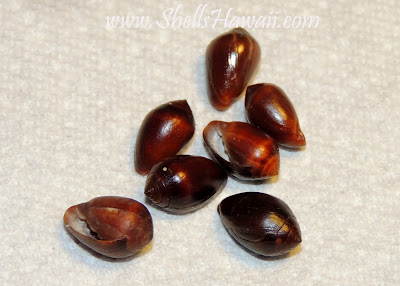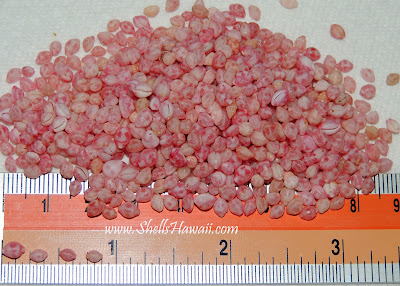Sunday, December 29, 2013
Thursday, December 19, 2013
Hawaiian Seashells Trivia
This information from the excellent Hawaiian Seashell book written by Mike Severns.
Trivia are often associated with Cowries (Cypraeidae) because of their ovate shells, but their shells differ from those of cowries by being sculptured with intricate currugations. The distinct nature of the corrugated patterns of each trivia species can be used as a key to identify the Hawaiian species. Trivias prey on colonial ascidians which can be found on the undersides of rocks and in cracks in the reef. They feed by inserting their long proboscis into one of the zooids and drawing out natrients. Most of Hawaii's trivia species are common in beach drift, indicating a shallow habitat, though one species is know to live as deep as 100 feet. Trivia species found in Hawaii are very small, not exceeding 5 mm.
Common name: small Trivia
Adult size: 5 mm
Depth 10-50 feet
Learn more about Trivia shells.
Picture by ShellsHawaii.com
Trivia are often associated with Cowries (Cypraeidae) because of their ovate shells, but their shells differ from those of cowries by being sculptured with intricate currugations. The distinct nature of the corrugated patterns of each trivia species can be used as a key to identify the Hawaiian species. Trivias prey on colonial ascidians which can be found on the undersides of rocks and in cracks in the reef. They feed by inserting their long proboscis into one of the zooids and drawing out natrients. Most of Hawaii's trivia species are common in beach drift, indicating a shallow habitat, though one species is know to live as deep as 100 feet. Trivia species found in Hawaii are very small, not exceeding 5 mm.
Common name: small Trivia
Adult size: 5 mm
Depth 10-50 feet
Learn more about Trivia shells.
Picture by ShellsHawaii.com
Sunday, December 1, 2013
Friday, November 29, 2013
Thursday, November 14, 2013
Nassarius papillosus (Linnaeus, 1758)
This shell are know as Nassarius Papillosus Linnaeus, 1758 or they called Basket shells.
Characteristic of this group is their long siphon which they wave about as they move accoss the bottom in order to detect prey, which usually consists of decaying animals such as fish and crabs. They also hunt for the source of chemicals given off by living prey such as bivalves.
At night time they are quite active, and the beauty of the remarkably colorful living animals can be seen as they crawl across the bottom.
For more information:
Nassarius papillosus (Linnaeus, 1758)
Nassarius papillosus is one of the two largest species of this family at Kwaj, with the largest specimens reaching at least 41.7mm. It is a very common species, often seen on lagoon, pinnacle and seaward reefs out foraging at night. It can also commonly be found in sand under rocks during the day, or even buried in small pockets of sand collected on the tops of lagoon pinnacles on on the shallow seaward reef. A very active shell, it can move quickly. It appears to be a favorite food of the large textile cone Conus textile, but is often able to escape being eaten by twisting its foot and hopping away from a predatory cone. It is commonly called the "pimpled basket" for obvious reasons.
Its egg capsules are small round balls deposited close together on the undersurfaces of rocks.
Characteristic of this group is their long siphon which they wave about as they move accoss the bottom in order to detect prey, which usually consists of decaying animals such as fish and crabs. They also hunt for the source of chemicals given off by living prey such as bivalves.
At night time they are quite active, and the beauty of the remarkably colorful living animals can be seen as they crawl across the bottom.
For more information:
Nassarius papillosus (Linnaeus, 1758)
Nassarius papillosus is one of the two largest species of this family at Kwaj, with the largest specimens reaching at least 41.7mm. It is a very common species, often seen on lagoon, pinnacle and seaward reefs out foraging at night. It can also commonly be found in sand under rocks during the day, or even buried in small pockets of sand collected on the tops of lagoon pinnacles on on the shallow seaward reef. A very active shell, it can move quickly. It appears to be a favorite food of the large textile cone Conus textile, but is often able to escape being eaten by twisting its foot and hopping away from a predatory cone. It is commonly called the "pimpled basket" for obvious reasons.
Its egg capsules are small round balls deposited close together on the undersurfaces of rocks.
Saturday, October 26, 2013
Thursday, October 10, 2013
Tuberose Miter shells / Hawaiian seashells
Tubersore Miter shells
These are among the most elegantly coloed and shaped of all the miters. They are predatory living their entire lives buried in sand. They can occasionally be seen on the surface of the sand at night when they are more actively hunting. The mature size is about 13 mm.
To see our collection of Hawaiian seashells jewelry Please visit ShellsHawaii.com
Mahalo,
Janjira
These are among the most elegantly coloed and shaped of all the miters. They are predatory living their entire lives buried in sand. They can occasionally be seen on the surface of the sand at night when they are more actively hunting. The mature size is about 13 mm.
To see our collection of Hawaiian seashells jewelry Please visit ShellsHawaii.com
Mahalo,
Janjira
Tuesday, October 8, 2013
Hawaiian Granulated Cowrie (Cypraea granulata)
Hawaii Granulated Cowrie (Cypraea granulata)
The shell of this quite uncommon cowry reaches on average 22–28 millimetres (0.87–1.1 in) in length, with a maximum size of 49 millimetres (1.9 in) and a minimum size of 15 millimetres (0.59 in).
The shape of the shell is wide oval and appears flattened. The dorsum surface is rough, with a deep longitudinal line in the middle and many protuberances of various sizes. These Cypraea granulate shells are commonly used for making clasps on our Hawaiian shell leis
Hawaiian Granulated Cowrie (Cypraea granulata)
The shinier ones are just a bit less mature than the duller ones. When these shells are very young they are smooth, shiny, and thin. As they get more mature, the bumps form and they starting getting thicker and begin to lose their shine. Both types are very desireable and collectible.
Please visit ShellsHawaii.com to see more collection and learn more about Hawaiian shell jewelry.
The shell of this quite uncommon cowry reaches on average 22–28 millimetres (0.87–1.1 in) in length, with a maximum size of 49 millimetres (1.9 in) and a minimum size of 15 millimetres (0.59 in).
The shape of the shell is wide oval and appears flattened. The dorsum surface is rough, with a deep longitudinal line in the middle and many protuberances of various sizes. These Cypraea granulate shells are commonly used for making clasps on our Hawaiian shell leis
Hawaiian Granulated Cowrie (Cypraea granulata)
The shinier ones are just a bit less mature than the duller ones. When these shells are very young they are smooth, shiny, and thin. As they get more mature, the bumps form and they starting getting thicker and begin to lose their shine. Both types are very desireable and collectible.
Please visit ShellsHawaii.com to see more collection and learn more about Hawaiian shell jewelry.
Monday, October 7, 2013
Rock shell / Brown Scaly drupe shell
This is one of the Rock shells. The rock shells live along rocky shorelines usually exposed to rough water and thus lack the elaborate projections of other murexes shich would only catch the water and make them more likely to be torn from the rock.
Hawaiian Brown Drupe shell necklace
Single strand Kahelelani shell lei. Simple beach style designed with brown Kahelelani shells that add the perfect contrast to the colors of the brown drupe and Tiger puka shells.
Hawaiian Brown Drupe shell necklace
Single strand Kahelelani shell lei. Simple beach style designed with brown Kahelelani shells that add the perfect contrast to the colors of the brown drupe and Tiger puka shells.
Thursday, October 3, 2013
Sunrise shells / Langford 's Pecten
These shells are known as Sunrise shells because they're easiest to spot in the early morning and they resemble a Hawaiian sunrise. They are unique to Hawaii and matching sets are incredibly rare and hard to find. The sunrise shells below can be purchased individually and/or used to create your custom jewelry.
To see our collection of Hawaiian Sunrise shells please visit ShellsHawaii.com
To see our collection of Hawaiian Sunrise shells please visit ShellsHawaii.com
Subscribe to:
Comments (Atom)

































.jpg)
.jpg)


















